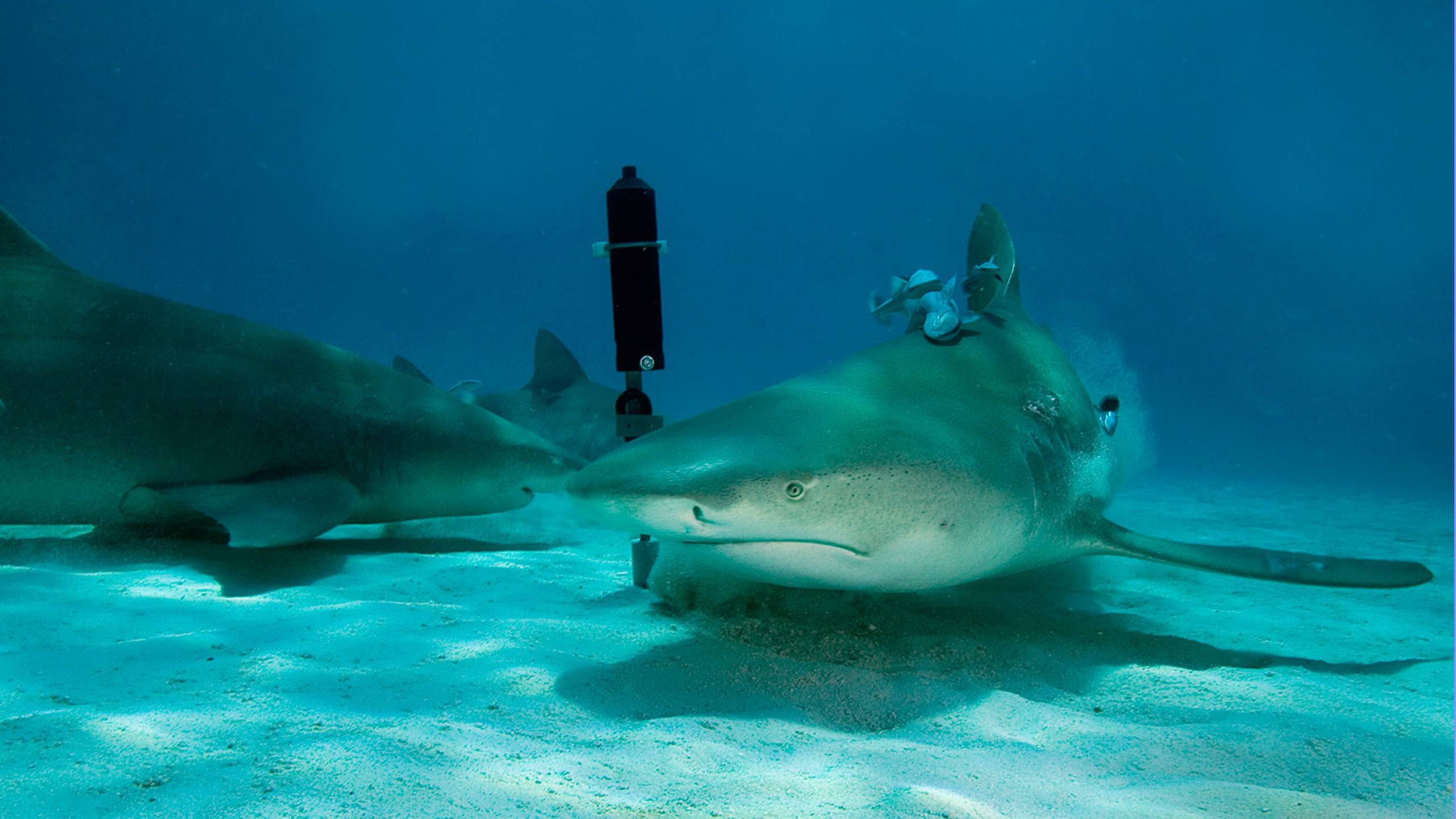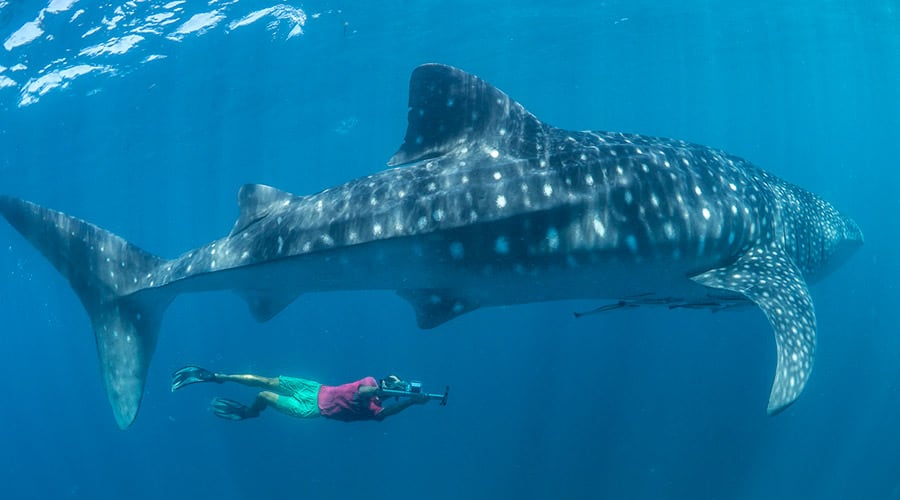Whale sharks are the largest living shark species. These peaceful giants feed on plankton and travel great distances in their search for food. Whale sharks are found on the IUCN Red List and on Appendix II of CITES and in the "Convention on Migratory Species" where they are designated a globally endangered species. Serious threats are direct fishing and bycatch, especially in fishing nets floating on the surface of the water. Since they often swim directly underneath the water surface when feeding, they are often injured or even killed by ships or boats.
Working with whale sharks
Photo © Simon Pierce
Background
Whale sharks feed on plankton and gather regularly in specific regions in times of plankton bloom. Since whale sharks are found around the world and have naturally low population sizes, these periodic aggregations form an important aspect of their ecology.
Their populations are declining rapidly. They are listed on the Red List of the IUCN as "vulnerable" and are listed in Appendix I and II of the Convention on the Conservation of Migratory Species of Wild Animals (CMS).
We know very little about the biology of whale sharks, e.g. what do they eat and where? How and where do they reproduce? Do their global populations mix or are they genetically separate from each other?
Goal
In order for protection to be successful, the critical habitats and migratory routes of the whale sharks must be identified and protected. In addition we must generally learn more about their biology.
The team from the Marine Megafauna Foundation working with Dr. Simon Pierce and Dr. Chris Rohner examines broader aspects of whale shark populations worldwide in order to provide them with more effective protection through better understanding of their biology, behavior, biochemistry and genetics.
One of the many goals is to establish a whale shark sanctuary in the region of Tofu, Mozambique. In this region whale sharks are frequently sighted and are examined by the team. The dangers lurking for the sharks here are the gillnets of local fishermen and from boats.
Methods
In addition to work being done in Mozambique to establish a marine sanctuary for whale sharks, the team of Simon Pierce and Chris Rohner, together with local and international scientists, is studying various ecological, genetic and biochemical aspects of whale shark populations around Mafia Island (Tanzania), the Red Sea, the Persian Gulf, the Philippines, Mexico (Yucatan), the Galapagos and a new whale shark hot spot around Madagascar.
Results
Various projects and locations include:
Global
- IUCN Red List of Endangered Species: In 2017 the official assessment of the global number of whale sharks was updated and extended by data from the Arabian Sea. Current numbers point to an approximate 50% decrease in worldwide whale shark populations since 1980, with no signs of any recovery since then.
- UN Convention on Migratory Species: A very significant success for whale shark protection was achieved in 2017. Based on IUCN data compiled by the team of Dr. Simon Pierce and other researchers, whale sharks were placed under the highest protection (Appendix I) of the UN Convention on Migratory Species (CMS). Aim of the CMS is to protect migratory species not only in specific countries but throughout their entire territory.
Madagascar
- A significant reduction of individuals in all larger whale shark populations was noticed in the western Indian Ocean, especially in Mozambique and the Seychelles. The newly found whale shark population in Madagascar thus becomes all the more important. Fortunately, this aggregation is considerably larger than assumed up until today. Since 2015 more than 240 sharks were identified.
Mexico
- Genetic studies have shown that the migration of Atlantic whale sharks is extremely rare in the Pacific or Indian Oceans. Based on the current state of scientific knowledge, two whale shark populations could be identified, an Atlantic and an Indopacific one.
Galapagos
- The Galapagos Island Darwin is the only worldwide location known today where fully mature, pregnant whale shark females are sighted. Small tissue samples taken from these females should provide information on their population genetics as well as their feeding habits (stable isotopes and fatty acid analysis). The sharks were also tagged with satellite transmitters (not financed by the Foundation) in order to study their migratory routes.
- In 2017 the project gained prominence thanks to its introduction in the world renowned BBC Production Blue Planet 2, an important public relations spot for the endangered whale sharks.
- In the 2018 expedition to the Galapagos the team succeeded for the first time ever in applying ultrasound to examine the gestation of 21 free swimming and most likely pregnant females. The collected data is still being evaluated. In addition, blood samples were taken from 6 females. Previous attempts to take blood samples from 10 to 12 meter long adult whale sharks for hormonal testing had failed due to their more than 25 cm thick skin. This time the Pierce and Rohner team found an area on the shark with much thinner skin. Tissue samples will provide information on genetic relationships to other locations.
- In 2019 an additional expedition headed for the Galapagos.
Mafia Island, Tanzania
- The whale sharks around Mafia Island are probably the best studied population from a genetic and biochemical angle. These studies continued in 2019, among other things focusing on differences between female and male whale sharks. Also in 2019 many returning whale sharks as well as some new ones were observed.
- Preparing for the beginning of whale shark tourism, and based on its respective extensive experience in Tanzania, the team compiled appropriate guidelines which it then presented to the responsible authorities.
Mozambique
- The work in Mozambique, including research on the network of whale sharks in the various Indo-Pacific as well as Arabian regions, continues.
Worldwide research on their biology:
- Various analyses on the biology of whale sharks run parallel to protection efforts. Research is thus being conducted to find out where adult females and males stay after they leave the "hot spots." First results indicate that they spend the rest of their lives in open waters on the high seas.
- How do whale sharks navigate on the high seas? Movement analyses show that they occasionally submerge to depths of over 1,200 m. Is this how they better orient themselves to the earth’s magnetic field?
- Further research revealed that parasites accumulate their DNA on the surface of their hosts. This so-called iDNA (DNA won from invertebrates) was discovered for the first time in marine animals in this whale shark study.
- Modern techniques make it possible to analyze entire genomes from living organisms faster and at lower costs. Genomic DNA can provide considerably more detailed information on populations and their interactions compared to classical short DNA pieces. Applying these new technologies should enable a more detailed analysis of international whale shark populations.
By 2019 16 scientific papers had been published thanks to the support of the Foundation.
Project Status 2019
The team continues to follow the various subprojects.
Administrative Details
Project Status: Long-term project since 2009
Photos: © Simon Pierce
Project Leader: Dr. Simon Pierce, Dr. Chris Rohner
Funding: since 2009 approx. CHF 110,900







